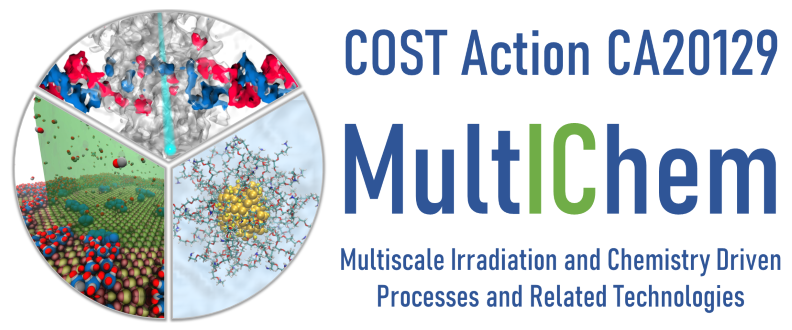The scientific program of the MultIChem 2022 Conference is outlined below. The program can also be downloaded as a pdf file.
Monday, May 16
| 0800 - 0915 | Participants registration |
| 0915 - 0930 | MultIChem 2022 Opening Alexey Verkhovtsev, Nigel Mason and Andrey Solov'yov |
| 0930 - 1100 | Morning session I: Irradiation-driven transformations of molecular systems (Chair: Alexey Verkhovtsev) |
| Andrey Solov'yov, MBN Research Center, Frankfurt am Main, Germany Multiscale modelling of irradiated MesoBioNano (MBN) systems with MBN Explorer and MBN Studio Nigel Mason, University of Kent, Canterbury, United Kingdom Experimental studies on radiation induced transformations of biomolecular systems and their application to radiotherapy Pablo de Vera, University of Murcia, Murcia, Spain The role of Monte Carlo simulations in multiscale modelling for biomedical and technological applications of radiation |
|
| 1100 - 1130 | Coffee break |
| 1130 - 1300 | Morning session II: Radiation-induced chemistry (Chair: Pablo de Vera) |
| Gérard Baldacchino, Université Paris-Saclay, CEA, Gif-sur-Yvette, France Huge dose rates in water can affect the initial equilibrium between ionization and excitation. Some expected consequences Brendan Dromey, Queen’s University Belfast, United Kingdom Ultrafast Nanodosimetry - investigating the role of nanoscale structure and dynamics during radiation interactions in matter Ilia Solov'yov, Carl von Ossietzky University of Oldenburg, Germany Modelling of dynamical processes in molecular systems with stochastic dynamics |
|
| 1300 - 1430 | Lunch |
| 1430 - 1615 | Afternoon session I: Collision, radiation and transport processes involving nano- and biomolecular systems (Chair: Nigel Mason) |
| Thomas Schlathölter, Zernike Institute for Advanced Materials, University of Groningen, the Netherlands Gas-phase studies as a tool to investigate molecular mechanisms underlying radiation damage Lorenzo Avaldi, Institute of Structure of Matter-CNR, Monterotondo, Italy Unveiling inter- and intra-molecular interactions in homogeneous and hydrated uracil clusters by photoelectron spectroscopy Theodoros Pavloudis, Nanomaterials Lab, University of Swansea, United Kingdom Large-scale multi-method simulations in nanocluster science Amir Kotobi, Deutsches Elektronen-Synchrotron (DESY), Hamburg, Germany Dynamic structure investigation and spectra prediction of peptides by machine learning techniques |
|
| 1615 - 1645 | Coffee break |
| 1645 - 1800 | Roadmap discussion Poster session |
Tuesday, May 17
| 0930 - 1100 | Morning session I: Irradiation-driven transformations of (bio)molecular and biological systems (Chair: Thomas Schlathölter) |
| Michael Hausmann, Kirchhoff-Institute for Physics, University of Heidelberg, Germany Irradiation and biochemistry driven (re)organization of membrane receptors and cell nucleus chromatin domains João Ameixa, University of Potsdam, Potsdam, Germany DNA radiation damage studies using DNA origami nanostructures Leo Sala, J. Heyrovský Institute of Physical Chemistry, Prague, Czech Republic Ionizing radiation-induced damage to DNA in solution probed using DNA origami nanosupports |
|
| 1100 - 1130 | Coffee break |
| 1130 - 1300 | Morning session II: Biomedical and technological applications of radiation (Chair: Andrey Solov'yov) |
| Richard Amos, Department of Medical Physics and Biomedical Engineering, University College London, United Kingdom Future directions in charged-particle radiotherapy: Opportunities and challenges Dirk Wagenaar, University Medical Center Groningen, Netherlands Radiobiological modelling in clinical treatment planning at the Groningen proton therapy center Gohar Tsakanova, Institute of Molecular Biology NAS RA, Erevan, Armenia Ultrashort pulsed electron beam irradiation: novel radiation modality for cancer treatment |
|
| 1300 - 1315 | Conference photo |
| 1315 - 1430 | Lunch |
| 1430 - 1600 | Afternoon session I: Nanofabrication with focused electron beams (Chair: Juraj Fedor) |
| Harald Plank, Graz University of Technology, Graz, Austria 3D nanoprinting via focused electron beams: principles and applications Alexey Verkhovtsev, MBN Research Center, Frankfurt am Main, Germany Atomistic simulations of irradiation-driven transformations involving organometallic systems Cornelis Hagen, Delft University of Technology, Delft, Netherland Electron beam induced growth of hollow nano-cones: experiments and simulations |
|
| 1600 - 1630 | Coffee break |
| 1630 - 1815 | Afternoon session II: Irradiation-driven chemistry in FEBID and FIBID processes (Chair: Harald Plank) |
| Lisa McElwee-White, Department of Chemistry, University of Florida Custom precursors for FEBID/FIBID: comparison of electron- and ion-induced chemistry Sven Barth, Goethe University, Frankfurt am Main, Germany Bimetallic precursors in focused particle-based deposition: FEBID vs. FIBID Iwona Szymańska, Nicolaus Copernicus University, Torun, Poland Processes induced by electrons in molecules of coordination compounds Cristiano Glessi, Delft University of Technology, Delft, Netherland Fabrication of high purity platinum nanostructures through water-assisted simultaneous FEBID/FEBIE |
|
| 1915 - 2200 | Conference dinner |
Wednesday, May 18
| 0900 - 1030 | Morning session I: Mechanisms of nanoparticle radiosensitization (Chair: Malgorzata Smialek-Telega) |
| Cécile Sicard-Roselli, Institut de Chimie Physique, University Paris Saclay, France Do we need to decipher radiosensitization mechanism to consider biological applications? Charnay Cunningham, Radiation Biophysics Division, iThemba LABS, National Research Foundation, Cape Town, South Africa Radiosensitization effect of gold nanoparticles in proton therapy Olivier Tillement, NH TherAguix, France Ultrasmall hybrid gadolinium-based nanoparticle as clinical radiosensitizer |
|
| 1030 - 1100 | Coffee break |
| 1100 - 1300 | Morning session II: Radiation-induced chemistry (Chair: Ilia Solov'yov) |
| Juraj Fedor, J. Heyrovský Institute of Physical Chemistry, Czech Republic Electron-induced chemistry: limits of single-collision-conditions data Duncan Mifsud, University of Kent, Canterbury, United Kingdom Laboratory studies of astrochemical ices using mid-infrared spectroscopy Matija Zlatar, University of Belgrade, Serbia Modeling metal-ligand bonds - from ground to excited states Malgorzata Smialek-Telega, Gdansk University of Technology, Gdansk, Poland Cresols: the influence of the functional group positions |
|
| 1300 - 1315 | Final Discussion and MultIChem 2022 Closing |
| 1315 - 1430 | Lunch |
| 1430 - 1700 | MultIChem Management Committee Meeting |
